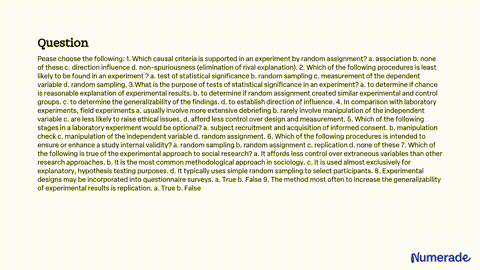Clinical or Case Studies In 2011, the New York Times published a feature story on Krista and Tatiana Hogan, Canadian twin girls. These particular twins are unique because Krista and Tatiana are conjoined twins, connected at the head.
Different Levels of Observation | Institute for Learning and Brain Sciences (I-LABS)
Question: ?______ assesses the consistency of observations by different observers.Group of answer choicesValidityAttritionA control groupInter-rater reliability _ _ _ _ _ _ a s s e s s e s the consistency o f observations b y different observers. Group o f answer choices Validity Attrition A control group Inter – rater reliability

Source Image: pinterest.com
Download Image
In addition, researchers often compare observations of the same event by multiple observers, in order to test inter-rater reliability: a measure of reliability that assesses the consistency of observations by different observers. The final drawback of naturalistic observation is the issue of consent to participation in the study.

Source Image: numerade.com
Download Image
Reliability in Psychology Research: Definitions & Examples In addition, researchers often compare observations of the same event by multiple observers, in order to test inter-rater reliability: a measure of reliability that assesses the consistency of observations by different observers. SURVEYS. Often, psychologists develop surveys as a means of gathering data.

Source Image: cell.com
Download Image
Assesses The Consistency Of Observations By Different Observers
In addition, researchers often compare observations of the same event by multiple observers, in order to test inter-rater reliability: a measure of reliability that assesses the consistency of observations by different observers. SURVEYS. Often, psychologists develop surveys as a means of gathering data. Describe the different research methods used by psychologists. Discuss the strengths and weaknesses of case studies, naturalistic observation, surveys, and archival research. There are many research methods available to psychologists in their efforts to understand, describe, and explain behavior and the cognitive and biological processes that
The Histone Deacetylase SIRT6 Is a Tumor Suppressor that Controls Cancer Metabolism: Cell
Jan 3, 2024Definition: Inter-rater reliability refers to the degree of agreement or consistency among different raters or observers when they independently assess or evaluate the same phenomenon, such as coding data, scoring tests, or rating behaviors. It is a measure of how reliable or consistent the judgments or ratings of multiple raters are. Cognitive Differences | Autism Internet Modules

Source Image: autisminternetmodules.org
Download Image
SOLVED: 7. assesses the consistency of observations by different observers. A. Attrition B. Inter-rater reliability C. A control group D. Validity. 8. A negative correlation means A. a third variable eliminates a Jan 3, 2024Definition: Inter-rater reliability refers to the degree of agreement or consistency among different raters or observers when they independently assess or evaluate the same phenomenon, such as coding data, scoring tests, or rating behaviors. It is a measure of how reliable or consistent the judgments or ratings of multiple raters are.

Source Image: numerade.com
Download Image
Different Levels of Observation | Institute for Learning and Brain Sciences (I-LABS) Clinical or Case Studies In 2011, the New York Times published a feature story on Krista and Tatiana Hogan, Canadian twin girls. These particular twins are unique because Krista and Tatiana are conjoined twins, connected at the head.

Source Image: modules.ilabs.uw.edu
Download Image
Reliability in Psychology Research: Definitions & Examples In addition, researchers often compare observations of the same event by multiple observers, in order to test inter-rater reliability: a measure of reliability that assesses the consistency of observations by different observers. The final drawback of naturalistic observation is the issue of consent to participation in the study.

Source Image: simplypsychology.org
Download Image
The Iconology of Pinterest – GRIN Descriptive, or qualitative, methods include the case study, naturalistic observation, surveys, archival research, longitudinal research, and cross-sectional research. Experiments are conducted in order to determine cause-and-effect relationships.

Source Image: grin.com
Download Image
Research Design, Methodologies, and Methods | Emerald Insight In addition, researchers often compare observations of the same event by multiple observers, in order to test inter-rater reliability: a measure of reliability that assesses the consistency of observations by different observers. SURVEYS. Often, psychologists develop surveys as a means of gathering data.

Source Image: emerald.com
Download Image
Consumer Psychology of Groups and Society (Chapter 2) – The Cambridge Handbook of Consumer Psychology Describe the different research methods used by psychologists. Discuss the strengths and weaknesses of case studies, naturalistic observation, surveys, and archival research. There are many research methods available to psychologists in their efforts to understand, describe, and explain behavior and the cognitive and biological processes that

Source Image: cambridge.org
Download Image
SOLVED: 7. assesses the consistency of observations by different observers. A. Attrition B. Inter-rater reliability C. A control group D. Validity. 8. A negative correlation means A. a third variable eliminates a
Consumer Psychology of Groups and Society (Chapter 2) – The Cambridge Handbook of Consumer Psychology Question: ?______ assesses the consistency of observations by different observers.Group of answer choicesValidityAttritionA control groupInter-rater reliability _ _ _ _ _ _ a s s e s s e s the consistency o f observations b y different observers. Group o f answer choices Validity Attrition A control group Inter – rater reliability
Reliability in Psychology Research: Definitions & Examples Research Design, Methodologies, and Methods | Emerald Insight Descriptive, or qualitative, methods include the case study, naturalistic observation, surveys, archival research, longitudinal research, and cross-sectional research. Experiments are conducted in order to determine cause-and-effect relationships.